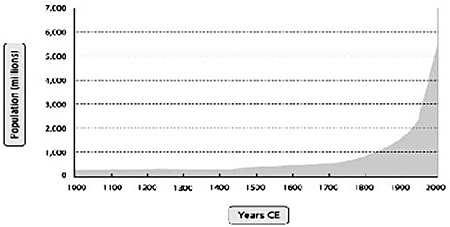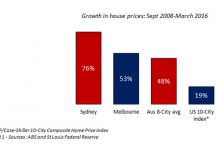When it comes to pollution, the health of the planet is related to how much resource each person uses. Therefore, the total impact we have on the planet is approximately the world’s population multiplied by the average standard of living. This is referred to as the “ecological footprint.”
The television programme, by David Attenborough, “How many people can live on planet Earth?” is a good reminder that we not only need to consider markets in the short term but also need to think about some important and long term determinants and how these will affect global financial conditions.
 Human Population – 1,000 A.D. to 2,000 A.D.
Human Population – 1,000 A.D. to 2,000 A.D.
The graph on this page shows how the world’s population began to grow more and more about three hundred years ago and the rate has gotten faster all the time. By the end of the second millennium there was a net gain of three new people every second of the day, or 259,200 every 24 hours. Despite the efforts of one or two countries there seems to be no sign of this rapid increase in population ceasing any time in the near future so it is quite probable that there could be an extra 2.5 billion people on this planet by 2050. This also goes hand in hand with the UN forecast of the world population being around 9.5 billion at the end of the first half of the 21st century. Using this guideline it means that there will be an extra fifty four million people in the world every year.
Until we devise a method of dumping all our rubbish in deep space, we have to recycle, burn or store everything we produce or consume. This means we have to be very careful how we do this as we cannot really afford to make Mother Nature angry with us since we rely on her for all our agriculture, energy and many other needs. Thus we go back to the ecological footprint of how many people use what and how efficiently we manage resources and control pollution.
There is an old survival maxim that the body cannot survive without air after 3-4 minutes, water after 3-4 days and food after 3-4 weeks. Therefore it does not take a genius to work out that we should look after these vital elements.
Assuming the above figures are correct, it has already been calculated that planet Earth cannot sustain 9.5 billion people. It presently cannot supply enough clean, potable water for those of us who exist today. Well over two billion people suffer from poor quality drinking water and water shortages – especially the two countries with the world’s largest populations.
Given the massive environmental costs that go with the ever increasing demands for water as a vital resource, the development of new, cost-effective solutions which would lead to a more efficient use of water is not only essential for the survival of the human race as we know it but financially attractive as well.
As intimated above, there is only so much water available to us and one of the big problems is that a lot of it is not in the same place as the people who actually need it. The continued growth of the world’s population as well as the creation of a middle class in developing countries means that the demand for water and more water intensive food such as meat is only going to increase.
Given all of this, it is easy to see why water is such a compelling investment story. It just goes back to the old tenet of ‘Supply’ and ‘Demand’. In China alone, money spent on improving the water infrastructure will be USD125 billion. This will provide many opportunities for western based companies to go and help the Chinese with things like water generation, filtration, ionization, purification and a host of more important factors which will increase the amount of potable water for the people of that nation.
As Steve Goldin, vice president of strategy indices at S&P states, “Water-based companies have been providing consistently strong returns. Speciality indices, such as the Global Water Index, are increasingly popular with investors. Due to its strong historic returns, we continue to witness investor demand.”
This is not to be sneezed at. Less than fifteen percent of China’s population can access safe drinking water from a tap and over more than 66% of the country’s 600 largest cities do not have enough water because of pollution or direct shortages.
However, let us not just concentrate on the eastern hemisphere. It should be remembered that this time last year California was planning water deliveries to irrigation districts and various cities throughout the state which were just five percent of their contracted allotments. According to the University of California the extremely severe rationing in the state has led to tens of thousands of farm workers losing their jobs and well over a quarter of a million acres of cropland being left uncultivated. This is important as it used to be an old adage that in America one farmer in the field of agriculture provided enough food for 35 people – five of which were overseas. This was no unplanned situation but directly related to the Morrill Land Grant College Act of 1862 which allocated land for the purpose of creating State Colleges with the requirement they must teach “agriculture and military science.” If America cannot sustain its food production then not only is it in trouble but so is the rest of the planet’s population.
To be continued…
The above data and research was compiled from sources believed to be reliable. However, neither MBMG International Ltd nor its officers can accept any liability for any errors or omissions in the above article nor bear any responsibility for any losses achieved as a result of any actions taken or not taken as a consequence of reading the above article. For more information please contact Graham Macdonald on [email protected]




